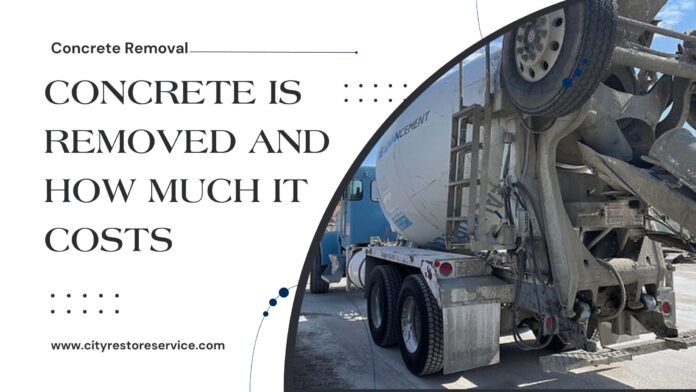Concrete removal is necessary for any building, remodeling, or demolition project. Understanding the various methods, prices, and safety considerations is critical whether you need to demolish a tiny concrete structure or remove big slabs of concrete. This article will walk you through the concrete removal process and provide insight into selecting the best solution for your needs.
Methods of Concrete Removal
Breaking and Removal
For small-scale tasks, breaking and concrete removal is a frequent procedure. It entails breaking the concrete into manageable pieces with handed equipment such as jackhammers or sledgehammers. These are then removed manually or with the assistance of machinery.
Chemical Concrete Dissolvers
Chemical concrete dissolvers are a common option for dissolving concrete that does not require mechanical effort. Further, these treatments work by dissolving the bonding chemicals in the concrete, transforming it into a soft and mushy consistency that can be easily washed away.
Hydrodemolition
Hydrodemolition is a precise and forceful concrete dissolver that uses high-pressure water jets to break the surface. Besides, this method is perfect for removing degraded or damaged concrete while preserving the underlying structure.
Pneumatic and Hydraulic Breakers
For larger concrete removal jobs, pneumatic and hydraulic breakers are used. Besides, these machines provide high-impact strikes to break down concrete surfaces effectively.
Diamond Wire Sawing
Diamond wire sawing is a cutting-edge method for removing big chunks of concrete with the least vibration and noise. Besides, this approach is frequently used in projects where precision and little environmental effect are critical.
Factors Affecting Concrete Removal
Concrete Thickness and Strength
The complexity and time required for removal are closely related to the thickness and strength of the concrete. Besides, thicker and stronger concrete may necessitate more robust removal techniques, raising overall expenses.
Accessibility and Site Conditions
The accessibility of the concrete structure and the site circumstances are important factors in determining the best removal strategy. Also, difficult-to-reach places may necessitate specialized equipment, which may delay the entire project duration.
Environmental Impact
It is critical to consider the environmental impact of concrete removal. Some methods generate more dust, noise, or pollutants than others, and choosing eco-friendly solutions can positively impact the environment.
Project Size and Timeline
The scale of the concrete removal project and the planned timeline influence the method chosen as well as the number of personnel needed. This may further affect the entire cost.
The Costs of Concrete Removal
Labor Costs
Labor costs account for a sizable amount of concrete removal costs. Besides, the project’s complexity and the number of workers employed will influence the overall labor expenses.
Equipment and Material Costs
Concrete removal equipment and materials, such as jackhammers, chemical dissolvers, and heavy machinery, add to the overall project cost.
Waste Disposal
Proper garbage disposal is critical and may result in increased costs. Besides, concrete waste recycling and reuse can reduce disposal costs.
Additional Costs
Unexpected occurrences and unexpected requirements during the project may result in increased costs. Therefore, a contingency budget is recommended.
DIY Concrete Removal – Pros and Cons
While DIY concrete removal may appear cost-effective, it is fraught with dangers and difficulties. Untrained individuals may lack the expertise or equipment required to complete the activity quickly and securely.
Hiring Professional Concrete Removal Services
Choosing the Right Contractor
When looking for expert concrete removal services, do your homework and find a trustworthy contractor who has worked on projects comparable to yours.
Obtaining Quotes and Estimates
Obtain detailed quotations and estimates from several contractors to compare costs and services.
Verifying Insurance and Licenses
Check that the chosen contractor has the necessary insurance and permits to protect you in the event of an accident or damage.
Understanding the Contract
Before signing, read and comprehend the contract thoroughly. Thus, making sure it includes all project information and expenses.
Safety Measures During Concrete Removal
Personal Protective Equipment (PPE)
All concrete removal employees must wear protective equipment such as hard helmets, goggles, gloves, and steel-toed boots.
Proper Equipment Handling
Proper equipment handling and operation are critical for avoiding accidents and injuries.
Site Preparation and Security
Use safety measures such as barricades and warning signs to restrict unauthorized entry to the work site.
Environmental Considerations
Recycling and Reusing Concrete Waste
Further, concrete trash recycling and reuse can help lessen the environmental impact of removal initiatives while promoting sustainable practices.
Reducing Carbon Footprint
Furthermore, choose eco-friendly disposal methods to reduce your carbon footprint and help the environment.
Sustainable Concrete Alternatives
Investigate using sustainable concrete alternatives in construction projects, such as recycled or low-carbon concrete.
Conclusion
Concrete removal is a major undertaking that requires careful consideration of numerous elements to ensure efficiency, safety, and cost-effectiveness. Further, whether you employ pros or do it yourself, understanding the available methods, costs, and environmental impact will help you make better decisions for your project. So,dissolve concrete with City Restore Service to do it efficiently yet easily.
FAQs
Is chemical concrete dissolver safe for the environment?
Yes, many chemical concrete dissolvers are designed to be environmentally safe and biodegradable.
How long does the hydrodemolition process take?
The time required for hydrodemolition depends on the size and complexity of the project, but it is typically faster than older methods.
Can I recycle the concrete waste from my project?
Yes, concrete waste can be recycled and reused in various construction applications.
What should I do with the leftover concrete debris after removal?
Contact your local garbage disposal facility to dispose of the concrete rubble properly.
Are there any eco-friendly alternatives to traditional concrete?
Yes, environmentally friendly concrete solutions, such as recycled and low-carbon concrete, are available.





